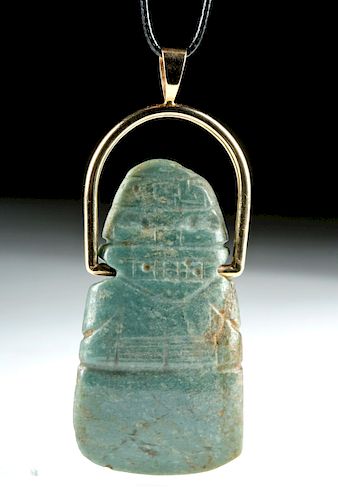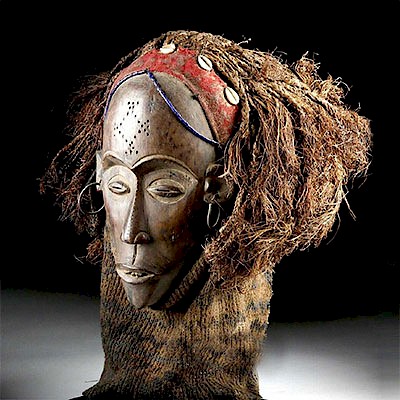Costa Rican Jade Axe God w/ 14K+ Gold Bale
Lot 93b
About Seller
Artemis Fine Arts
686 S Taylor Ave, Ste 106
Louisville, CO 80027
United States
Selling antiquities, ancient and ethnographic art online since 1993, Artemis Gallery specializes in Classical Antiquities (Egyptian, Greek, Roman, Near Eastern), Asian, Pre-Columbian, African / Tribal / Oceanographic art. Our extensive inventory includes pottery, stone, metal, wood, glass and textil...Read more
Estimate:
$900 - $1,400
Absentee vs Live bid
Two ways to bid:
- Leave a max absentee bid and the platform will bid on your behalf up to your maximum bid during the live auction.
- Bid live during the auction and your bids will be submitted real-time to the auctioneer.
Bid Increments
| Price | Bid Increment |
|---|---|
| $0 | $25 |
| $300 | $50 |
| $1,000 | $100 |
| $2,000 | $250 |
| $5,000 | $500 |
| $10,000 | $1,000 |
| $20,000 | $2,500 |
| $50,000 | $5,000 |
| $100,000 | $10,000 |
| $200,000 | $20,000 |
About Auction
By Artemis Fine Arts
Apr 4, 2019
Set Reminder
2019-04-04 10:00:00
2019-04-04 10:00:00
America/New_York
Bidsquare
Bidsquare : Ancient / Ethnographic From Around The World
https://www.bidsquare.com/auctions/artemis-gallery/ancient-ethnographic-from-around-the-world-4003
Ancient art from Egypt, Greece, Italy and the Near East, as well as Asian, Pre-Columbian, Native American, African / Tribal / Oceanic, Spanish Colonial, Russian Icons, Fine art, much more! All categories, all price ranges... all legally acquired and guaranteed to be as described or your money back Artemis Fine Arts info@artemisfinearts.com
Ancient art from Egypt, Greece, Italy and the Near East, as well as Asian, Pre-Columbian, Native American, African / Tribal / Oceanic, Spanish Colonial, Russian Icons, Fine art, much more! All categories, all price ranges... all legally acquired and guaranteed to be as described or your money back Artemis Fine Arts info@artemisfinearts.com
- Lot Description
Pre-Columbian, Costa Rica, Guanacaste-Nicoya, ca. 300 BCE to 500 CE. A finely carved and string cut jadeite anthropomorphic axe god celt with a mesmerizing visage presentig a toothy grimace and topped by a decorative headband incised with a running Greek key motif and a celt-shaped body with joined hands over the abdomen. This jadeite celt has been attached to a substantive arched 14K+ gold bezel (comprised of 60% gold) in order to be wearable. A very special example accompanied by a card stating that the late Robert Stroessner of the Denver Art Museum attributed it. Size: 2.625" H (6.7 cm); 3.5" H (8.9 cm) including modern 14K+ gold bezel. Comes with 20" L (50.8 cm) modern cord
The value of jade in the Pre-Columbian world lay in its symbolic power; scholars believe its color was associated with water and vegetation. Costa Rica, along with Mesoamerica, is one of the two regions where jade was extensively carved in the Pre-Columbian world. The earliest example of worked jade, a pendant excavated from a burial site on the Nicoya Peninsula, dated to the mid-first millennium BCE. It appears that jade continued to be carved into personal ornaments, usually depicting anthropomorphic deities or animals such as birds, monkeys, or frogs, until approximately 700 CE when gold became the favored material to fashion such ornaments.
Provenance: ex-HD Enterprise, Hank Johnson, Denver, Colorado, USA
All items legal to buy/sell under U.S. Statute covering cultural patrimony Code 2600, CHAPTER 14, and are guaranteed to be as described or your money back.
A Certificate of Authenticity will accompany all winning bids.
We ship worldwide and handle all shipping in-house for your convenience.
#144493Minor surface wear with minute nicks to celt edge. Inherent veining to stone. Jadeite axe celt is ancient. Gold bezel and cord are modern. Beautiful and wearable.Condition
- Shipping Info
-
All shipping is handled in-house for your convenience. Your invoice from Artemis Gallery will include shipping calculation instructions. If in doubt, please inquire BEFORE bidding for estimated shipping costs for individual items.
-
- Buyer's Premium



 EUR
EUR CAD
CAD AUD
AUD GBP
GBP MXN
MXN HKD
HKD CNY
CNY MYR
MYR SEK
SEK SGD
SGD CHF
CHF THB
THB














